I am sitting with Kim Adelman, author of the short filmmaking guide Making It Big in Shorts. The mood is mellow as we have drinks on the bright green, astroturfed patio for Sundance NextFest, amidst live screen printing and taco trucks. We have spent the afternoon watching a program of shorts at the Ace Hotel, and Kim has let me tag along as she hobnobs with filmmakers and film festival programmers. I admire her current choice of eyewear, from what seems an endless supply of cool glasses, as she chats with the director of the buzzy Thunder Road.
Wondering how she ended up the “indisputable queen of the short film world,” I am surprised when she tells me she didn’t go to film school. A friend of hers got her her first job at 20th Century Fox, she explains. One time, she recalls wryly, part of her job was to go outside and tell people not to look at Michael Bay’s car.
Kim runs into Kimberley Browning, the founder and director of the Hollywood Shorts Film Festival. Twenty years ago, the two became part of the same community supporting filmmakers, and began to be called “Kim A” and “Kim B” so they could be distinguished.
“Kim created this amazing film program for filmmakers through FXM,” says Kim B, “helping filmmakers really learn how to do short films that would have an impact.”
The impact? The nineteen short films that Kim produced for FXM played over 150 film festivals and won over thirty awards.
“When I made nineteen shorts,” Kim says, “I learned an awful lot. And I realized that so much of the information is taken from someone who’s done it before, passing it on to someone new who wants to make a short film or independent feature. All of the mistakes that I’ve made and that the filmmakers I know have made can help somebody who wants to start out. I think it’s very important to share the knowledge with the next generation.” When she kept getting asked to help her friends and their first-time filmmaker friends, she realized she had to write it down. “So I could say, ‘Here. Buy my book!’ ” she laughs.
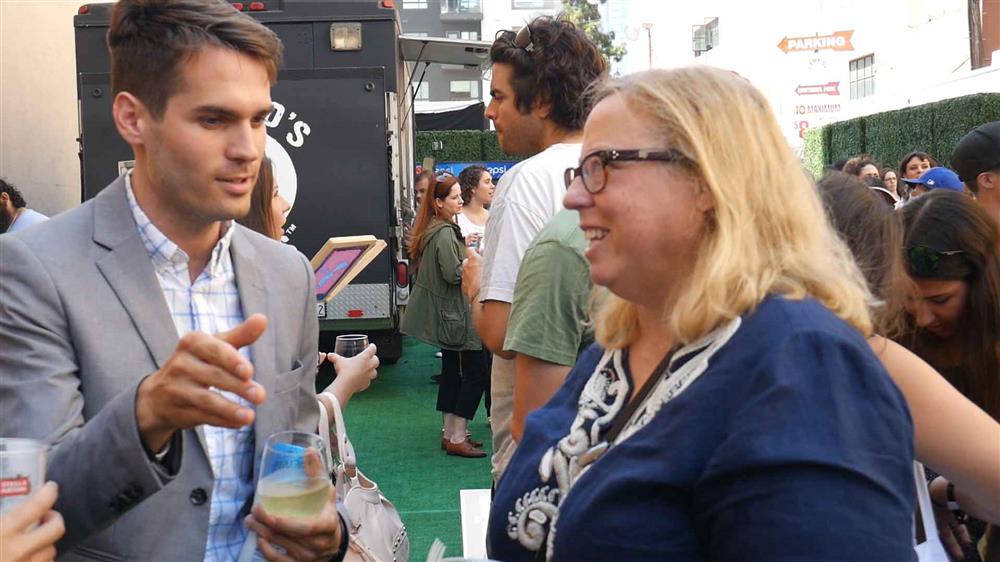
Making It Big in Shorts has just been printed in its third edition: “I have to keep updating my short film book because technology changes so much. The first edition was written before YouTube–which always blows people’s minds. There was a time when you couldn’t just upload anything that you made and send it out in the world! The second edition was written before crowdfunding, and that’s such an important part of filmmaking now. The third edition reflects our current state of filmmaking. A lot of my students who’ve taken my classes or who have read the book have gone on to be very successful, and that makes me very happy.”
One of Kim’s first students, director Lexi Alexander (Punisher: War Zone, Green Street Hooligans), took Kim’s short filmmaking and marketing class at UCLA Extension, and ended up winning an Oscar nomination for her short [Johnny Flynton]. “She’s done very well with action films and is currently directing Arrow.”
Having started her career in features, producing the independent romantic comedy Just Friends, Kim can speak to the creative freedom of shorts: “It’s extremely liberating to make short films. Anybody can shoot one on their iPhone, nobody’s going to stop you. You don’t need a degree. You don’t need a permit to make a short film. You don’t need a million dollars!” She laughs. “So that’s what I really love — the door is just so wide open. And that’s why they’re so interesting, because you get this real diversity of voices. You don’t have the gatekeepers saying, ‘Will teenage boys want to pay money to go see this?’ ”
Another great thing about shorts? “They don’t have marketing behind them, so when people say you have to see it, it really is great.”
Twelve years ago, Kim had just written The Ultimate Guide to Chick Flicks, a paean to the genre, and Andrea Richards had just written Girl Director. Together with Andrew P. Crane of the American Cinematheque in Hollywood, they programmed the first Focus on Female Directors Showcase. “The whole idea behind it was, let’s celebrate female directors at the short film level.” The showcase, which features short films directed by women, has been held every January since then, screening on the giant screen at the opulent Grauman’s Egyptian Theater in Hollywood.
“We really try to make sure we have an array of different filmmakers.” The program features women working across a large spectrum, including: documentary filmmakers, animators, actresses turned directors; the early short films of famous directors; and shorts that have won the Academy Award and the Cannes Palme d’Or. The program also takes a look back at where women directors started, featuring historical shorts by directors such as Mabel Norman, Cleo Madison and Lois Weber.

Some highlights in the past have included shorts by directors better known as feature film directors, like Sarah Polley, Sam Taylor Johnson, Penelope Spheeris, Mira Nair, Zoe Cassavetes, Jane Campion, Sofia Coppola, Miranda July, Andrea Arnold, and Niki Caro.
“One of our favorites was Jill Soloway, who had come from television. She made a terrific short called Una hora por favora, then she went on to make a feature, and now she’s made Transparent.”
Kim notes the importance of supporting actresses turned directors, because “they don’t always get the same shot as actors turned directors,” and names Jennifer Aniston, Kirsten Dunst, Julie Delpy, Isabella Rossellini, Brie Larson and Rose McGowan as directors that have been featured.
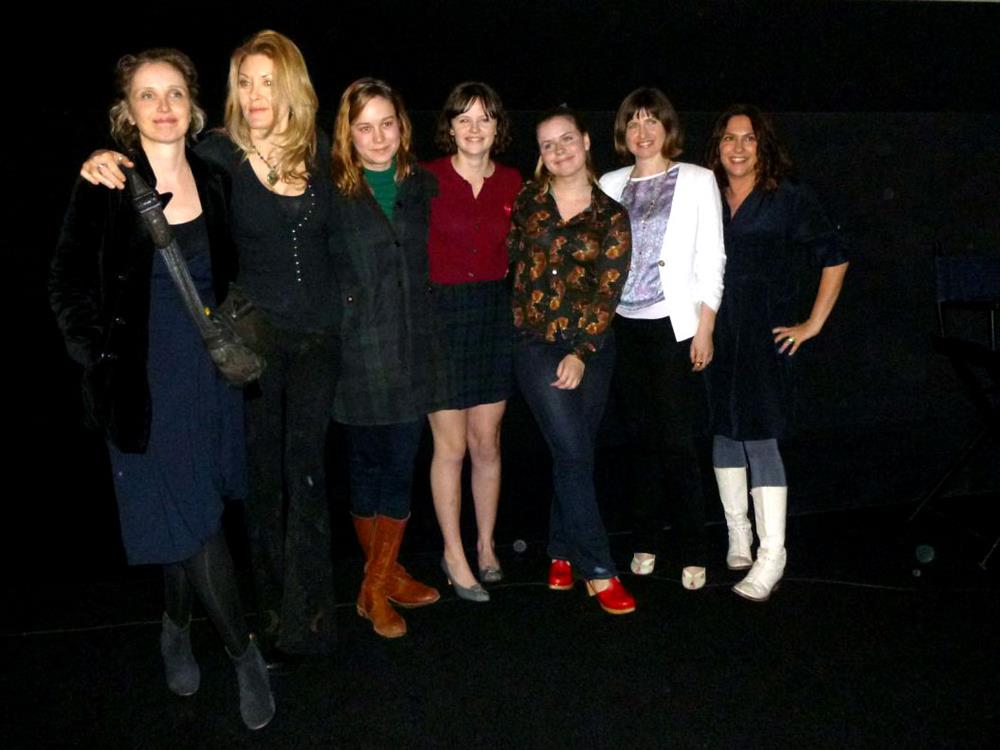
Perhaps the most important impact of the Focus on Female Directors Showcase is the community and empowerment it creates: “The filmmakers get to talk to the audience. And then the audience is so dedicated, they will follow these filmmakers when they make other things in the future or go back and see their other films.”
“People come up to us saying, ‘I’m going to make a film.’ That’s really the point, isn’t it? To encourage others. Because the more women that are directing, the more impossible it will be to stop us.”
I ask Kim about the different platforms for shorts: “You can buy short films from iTunes. There’re short films on iTunes, there’re short films on Amazon. So short films are out there, and people are paying for them. But, it is kind of like–would you personally pay to see a short film?” I confess to Kim that the only time I paid for a short was to see one featuring Benedict Cumberbatch. Kim laughs, identifying the celebrity aspect of it: “If there is a celebrity in it, some people are interested in them.”
As shorts aren’t necessarily lucrative, Kim offers a more helpful way the aspiring filmmaker can view shorts: “Short films really are like a calling card. Shorts are a wonderful way to display your talent and say, ‘Look, this is my original voice, this is what I can do.’ And there are tons of examples of people who have made a short film, and on the basis of that, have either used it as a proof of concept to make a larger film, or they have gotten hired to make some other film. That’s why I think shorts are so important.”
“The more women that are directing, the more impossible it will be to stop us.”
“At Focus on Female Directors, I was looking back and in our second showcase, we showcased a short film called Mother, that the director Sian Heder has just remade into a feature film called Tallulah, that’s out on Netflix now. So she took a short, used it as a proof of concept, and got to make her feature. There was also a short in either our first or our second Focus on Female Directors called B-Girl [directed by Emily Dell]. Same thing. So there’re a lot of examples of women who made a short, used that to make a lot of connections, and to show people–look at what I can do, there’s more story here, give me money and I will make a bigger film.”
There are a lot of filmmakers making shorts. “The statistic we always throw around is the number of shorts that get submitted to the Sundance film fest, which last year was almost 9,000. In one year. And then Sundance only programs 72.”
Of the top film festivals worldwide, the ratio of men to women directors in shorts is two to one. However,the percentage of women directors plummets from about a third at the short film level to 4% for the top box office features, as noted in a 2015 study by the Media, Diversity, & Social Change Initiative.
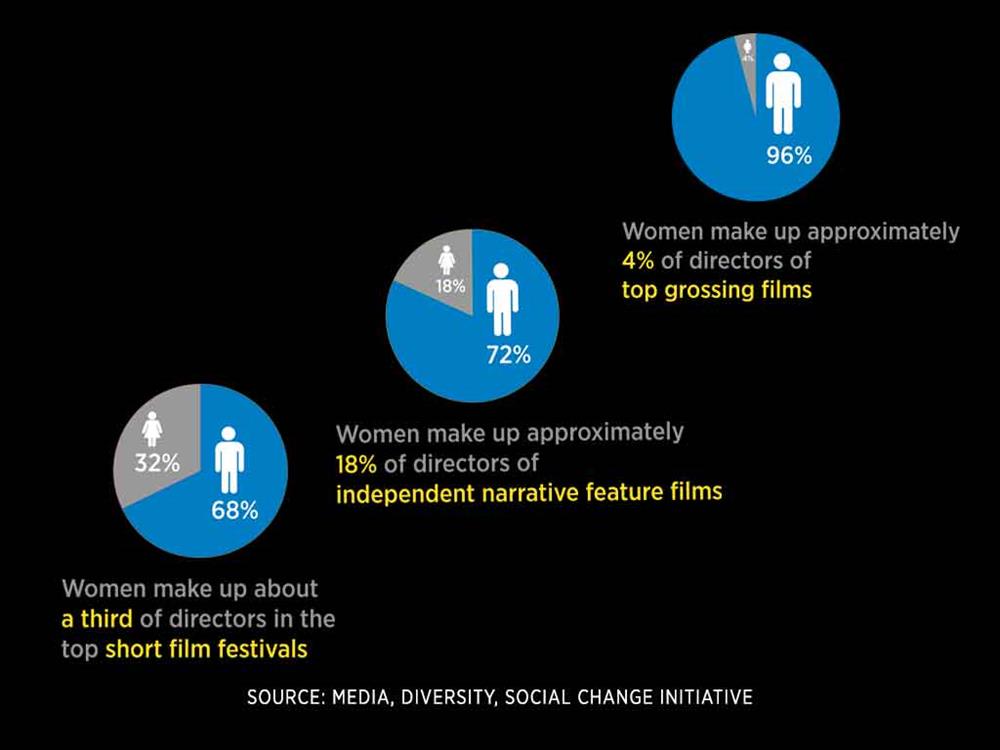
I ask Kim about the difficulty women may have parlaying a short that is successful on the festival circuit to a first feature film, relative to men. “I’ve a couple thoughts on that. Number one, it’s hard for everybody. I know so many directors where it’s taken them five years from making the short to making the feature. Even really well-connected directors. And I think that one of the reasons is the material they want to do next is not necessarily commercial. For a feature, if someone’s investing a million, or two million, or twenty million, or two hundred million, they want a return on that investment. It’s a money-making business.”
“However,” she continues,“why are women who want to really make super commercial things not able to make super commercial things? I think one of the main problems is the people who are hiring need to be more aware of the fact that there’s prejudice or there’s unconscious bias against it.”
Kim recalls an instance of this: “When we were making short films at the Fox Movie Channel, there was no rule about who we had to hire. My boss, who was a white male, and I put together the list of directors that we were interested in. He didn’t notice it, but I did, that everybody on the list was a white male.”
“I asked a female director, did she know anybody? And she recommended an Asian American director named Jessica Yu, who actually ended up being the first filmmaker we made a film with. Jessica had already made a terrific short doc, and she got nominated and then won her Academy Award for that short doc. We would never have made that short with Jessica if we hadn’t thrown our net out wider. Then we could say right away, ‘We’ve got Academy Award-winning filmmakers making films for us.’ The fact that we could be in business with her was a huge deal.”
“Don’t put a lot of money into it. Make films that you can make with the resources that you have.”
“So I always think about that,” she says reflectively. “That it’s so important to have opportunities for everybody and that you really look at who you’re considering. And it benefits everybody. It benefited Jessica to get an experience doing narrative, coming from documentary. She has now done great in television, and she’s directed features. I’m very proud of everything she’s done.”
Another way to ensure diversity, says Kim, is in education: “It’s really important that there’s opportunities to make shorts when in high school. Not everybody has that opportunity. So it’s important that we get proper funding in schools because media literacy is so important. That everybody has access to computers for editing, and to digital cameras. And that’s how we’ll get more voices out there, starting young.”
TV has been more responsive to women directors, she observes: “I will say, a lot of the directors whose short films I produced have been very successful at becoming television directors. In television there’s more opportunity, primarily because there’s more openings. You know, you’re going to make 22 episodes of a show per season, or even 12, that’s a lot of directors who get a shot. With Hollywood movies, they’re not making as many movies–there’s not as many shots.”
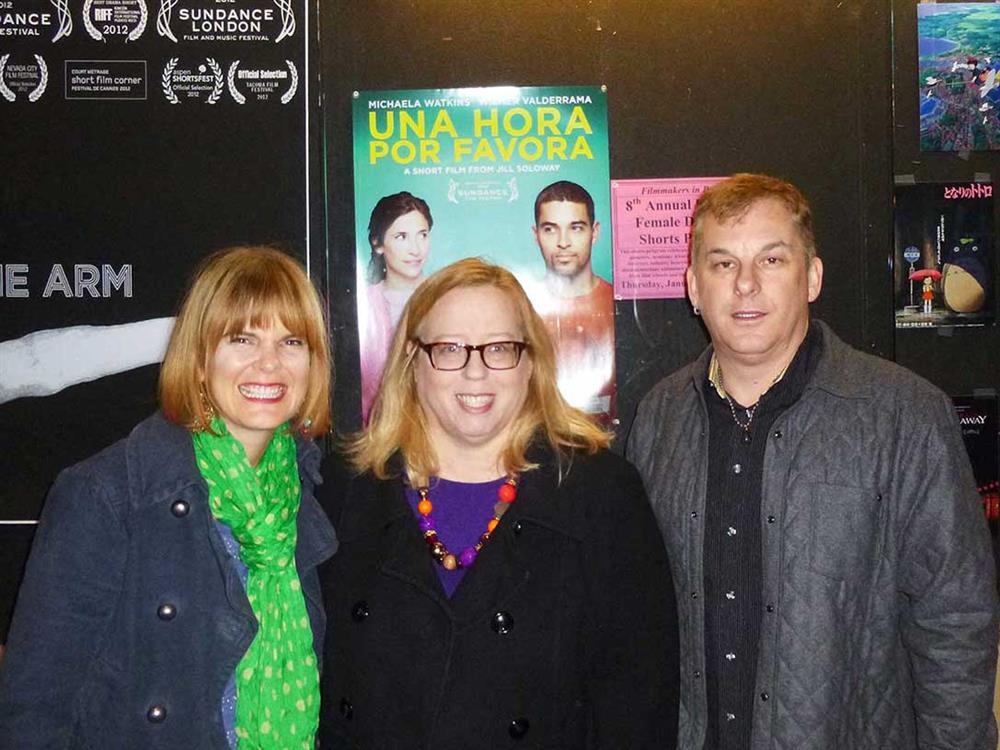 |
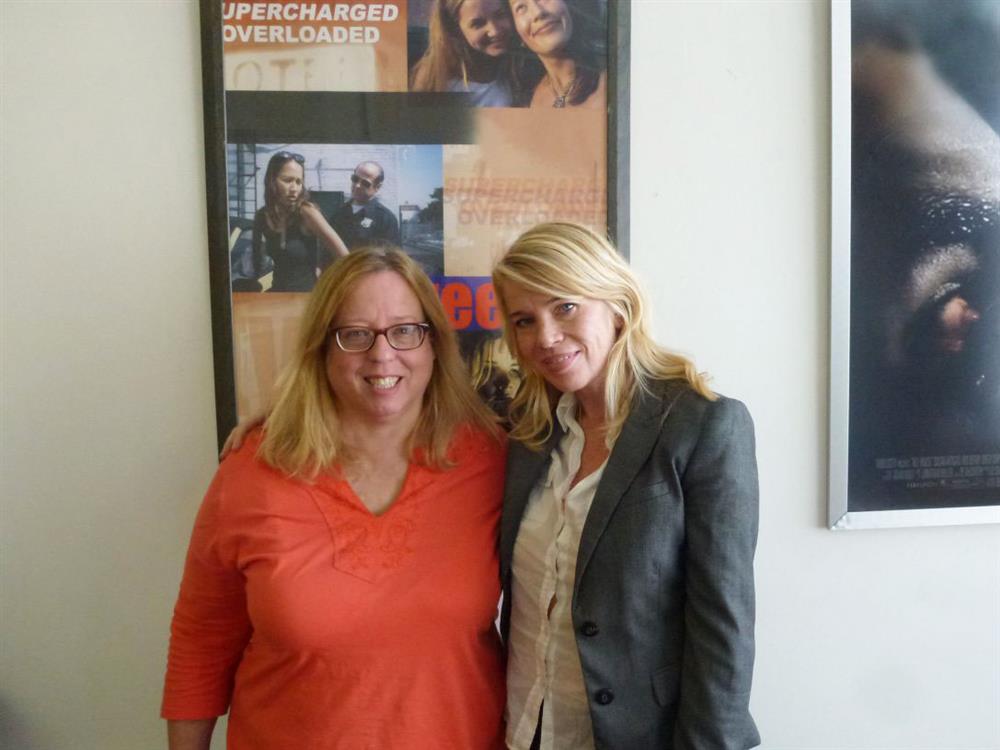 |
| Kim with Focus on Female Directors Co-Founders Andrea Richards and Andrew P. Crane | Kim with Female Filmmaking Collective Co-Founder Christina Beck |
Another aspect that may be holding women directors back is support behind a film. “When you look at the number of films directed by women, there’s just not that many, and there’s not as many in the top ten. And is it because these films are not marketed?”
“Sam Taylor Johnson directed 50 Shades of Gray, which was one of the most successful films of recent time. We showed her short film at Focus on Female Directors and if you see that film, you say ‘This woman is incredibly talented,’ and ‘She can make a feature like that.’ One of the reasons 50 Shades of Gray made all that money is it had an IP value and it made a ton of money because of marketing. If your film does not have marketing behind it, how successful can it be?”
“How do you make change?” she muses.“There have been talks about perhaps there need to be lawsuits. Maybe the government needs to step in. Maybe we need to do some sort of action to force the numbers. I have a friend who says we should all be chaining ourselves up to the DGA until things change. Obviously I’m not going to be the one to solve all of that. But I do think consciousness raising is important. I do think shaming is also important. Calling out via social media: do you realize this studio has 20 films and not a single woman is directing one? Unless somebody points it out, nobody’s going to pay attention.”
One of the results of the community brought together by the Focus on Female Directors showcase was the Female Filmmaking Collective. “When we first started Focus on Female directors, one of our first filmmakers was a director named Christina Beck who said we need to keep this ongoing and do it year-round. She and I started the Female Filmmaking Collective. Let’s get together and encourage other people. And because social media is so wonderful, it doesn’t have to be just people in Hollywood. So we started it as a Facebook page, but one of the things that we discovered almost right away was that we didn’t just want to be virtual. So much goodwill, energy, information and support happens when we’re face to face. It’s so tempting now to just think via social media we can make things happen or communicate. But it’s important who you know and who you connect with, and that happens face to face.”
The Female Filmmaking Collective organizes events around film festivals: “We often support by going as a group to see films. Early on we went to see Lena Dunham’s Tiny Furniture when it played at the LA Film Festival. We’ve also done workshops where we bring in experts to show how we can use social media to improve and promote ourselves, which sometimes women have a hard time doing.”
The collective has also partnered with other organizations: “We’ve also done mixers when important people come to town, to come together and celebrate them. So we did have a nice group meeting with Melissa Silverstein from Women and Hollywood, Ava DuVernay, and it was like a mafia meeting [laughs] of all the important people to talk about how we can work together.”
“It’s extremely liberating to make short films. Anybody can shoot one on their iPhone, nobody’s going to stop you. You don’t need a degree. You don’t need a permit to make a short film. You don’t need a million dollars!”
Kim has a lightning quick answer when I ask who her hero is: Geena Davis, who founded the Geena Davis Institute on Gender Studies in 2006: “The fact that she formed an institute [on gender studies] is worship-worthy enough, but she is going around to studios, showing them what the problem is with not having enough female characters, and offering solutions.” Kim enthuses that Geena is producing a documentary about the lack of women directors in Hollywood and that she has formed the women- and diversity-promoting Bentonville Film Festival: “The winner is guaranteed distribution, which is completely unheard of.”
“I’m a member of her institute,” Kim continues. “I go support all the events that she’s done. Every time I hear her speak I just think, this woman knows what she’s talking about. She’s so wonderful at explaining how to make a difference–just include more female characters. And she’s speaking to people who really can make a difference, so go Geena!”
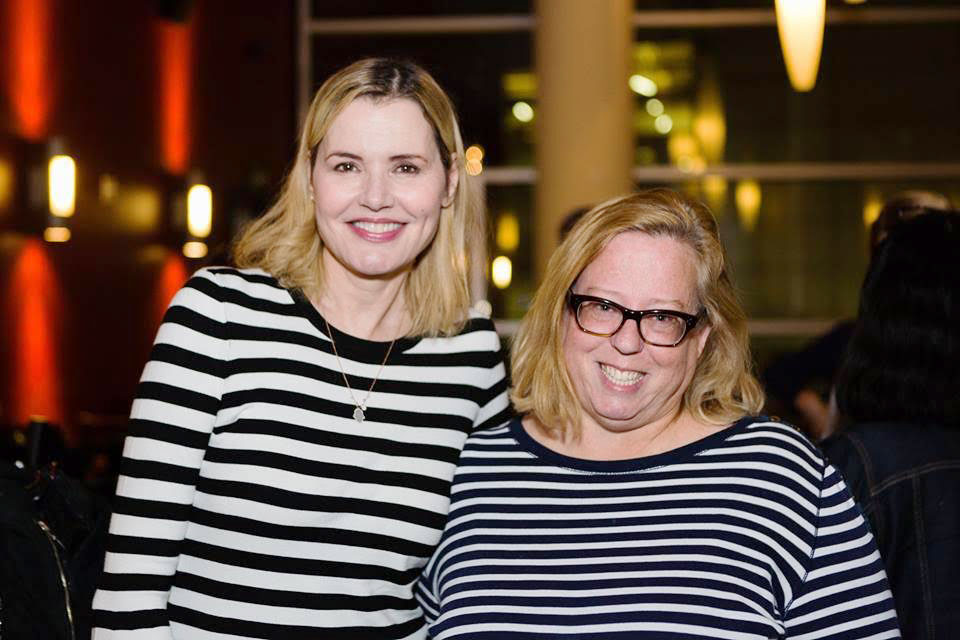
Kim runs into Destri Martino of the Director List, a database of over a thousand women directors, who tells me how Kim guided her as a filmmaker. Destri had won the Focus on Female Directors trailer contest in 2011: “I just did this really simple, one-minute trailer about female directors. It was animated with stick figures. Kim was so positive about it and so encouraging. She said, ‘This can be a little movie on its own. You should send it out to film festivals and see how it does.'”
Destri had done an eight-minute short shot on 16mm: “That got into a couple film festivals. But my one-minute animated stick figures got into 25! And that’s all thanks to Kim. You need that person who’s going to be encouraging you and watching out from an objective standpoint. Who knows what’s going on in the world of film and keeps pushing you. And Kim has definitely been that for me.”
I ask Kim what, in a nutshell, is her advice for the would-be short filmmaker. “My best advice is don’t put a lot of money into it. Make films that you can make with the resources that you have, the topics that you’re interested in. With short films, there’s no expectation other than you’re making something you want to share with people. Don’t be intimidated. Social media has given us so many platforms to make little things. Make something on Vine, make something on Periscope. You can shoot it on your iPhone, you can shoot it on a borrowed camera. Just make it less than ten minutes long, and I guarantee, you can put it up on YouTube and you’ll find an audience. So, make a short film. You’ll never regret it.”
makingitbiginshorts.wordpress.com
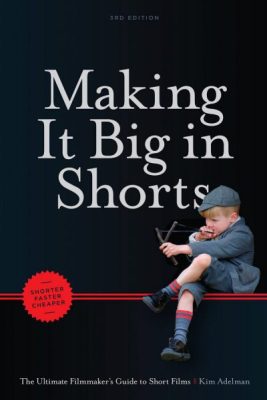
Page created on 6/1/2017 11:14:35 PM
Last edited 2/24/2021 11:43:44 PM
